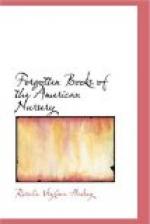life would savor too much of ridiculing those things
that were sacred and serious to the people of that
day. Yet the main incidents of the story were
these: Henry’s conversion took place after
a year and a half of hard work on the part of a missionary,
who finally had the satisfaction of bringing little
Henry “from the state of grossest heathen darkness
and ignorance to a competent knowledge of those doctrines
necessary to salvation.” This was followed
immediately by the offer of Henry to give all his toys
for a Bible with a purple morocco cover. Then
came the preparations for the teacher’s departure,
when she called him to her room and catechized him
in a manner worthy of Cotton Mather a century before.
After his teacher’s departure the boy, mindful
of the lady’s final admonition, sought to make
a Christian of his bearer, Boosy. Like so many
story-book parents, Henry’s mother was altogether
neglectful of her child; and consequently he was left
much to the care of Boosy—time which he
improved with “arguments with Boosy concerning
the great Creator of things.” But it is
not necessary to follow Henry through his ardent missionary
efforts to the admission of the black boy of his sinful
state, nor to the time when the hero was delivered
from this evil world. Enough has been said to
show that the religious child of fiction was not very
different from little Elizabeth Butcher or Hannah Hill
of colonial days, whose pious sayings were still read
when “Little Henry” was introduced to
the American child.
Indeed, when Mrs. Sherwood’s fictitious children
were not sufficiently religious to come up to the
standard of five-year-old Henry, their parents were
invariably as pious as the father of the “Fairchild
Family.” This was imported and reprinted
for more than one generation as a “best seller.”
It was almost a modernized version of Janeway’s
“Token for Children,” with Mather’s
supplement of “A Token for the Children of New
England,” in its frequent production of death-bed
scenes, together with painful object lessons upon
the sinfulness of every heart. To impress such
lessons Mr. Fairchild spared his family no sight of
horror or distress. He even took them to see
a man on the gallows, “that,” said the
ingenuous gentleman, “they may love each other
with a perfect and heavenly love.” As the
children gazed upon the dreadful object the tender
father described in detail its every phase, and ended
by kneeling in prayer. The story of Evelyn in
the third chapter was written as the result of a present
of books from an American Universalist, whose
doctrines Mrs. Sherwood thought likely to be pernicious
to children and should be controverted as soon as
possible. Later, other things emanating from
America were considered injurious to children, but
this seems to be the first indication that American
ideas were noticed in English juvenile literature.




